
Back in the days of the Industrial Revolution, philosopher Jeremy Bentham proposed the carrot-and-stick approach to motivation. Based on an old anecdote, this theory suggested that people could be motivated by reward and punishment. While the concept of punishment is outdated, the idea of motivation through rewards has evolved significantly in the modern workplace.
So what rewards are employees looking for today?
Well, surprisingly or not, it’s not primarily about money. It’s employee training and development. Lauren Hasson, Founder of DevelopHer, states that "when employees feel invested in and that their value is recognized, their engagement and loyalty to a business tends to increase which in turn positively impacts a businesses the bottom line."
Case in point: Surveys from LinkedIn and Udemy echo this sentiment, revealing a strong preference for career development opportunities over monetary rewards. A staggering 94% of all employees interviewed for LinkedIn’s Workplace Learning Report said that they would stay longer with a company that invested in their careers. In another survey, Udemy found that learning and development is the most important benefit to almost half of Millennials.
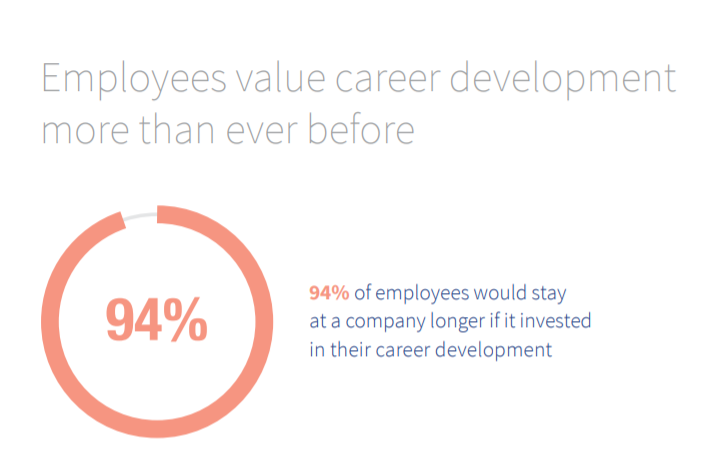
Today’s employees are looking for jobs that give them meaning and help them grow. As Career Coach Emily Eliza Moyer says, “If managers can guide employees to connect their individual purpose back to the work they do every day, and even better, back to the company mission, they’ll be drawing from the deepest source of motivation. Purpose is the greatest driver for both impact and fulfillment.”
But, then, there is the other side of this equation. Ongoing employee training is not just something workers want. It’s something they need.
With AI and other technologies advancing at ultrasonic speed, the urgency for employee training and development has grown as well. Research from McKinsey reveals that 87% of companies worldwide recognize that they either already face a skills gap or will within a few years.

(Source)
This underscores the urgent need for businesses to prioritize employee training initiatives like reskilling and upskilling. In fact, the same study found that 53% of respondents identified skill building as the most effective action to close capability gaps within the next year, making it the top-ranked strategy.
Furthermore, Wiley's Closing the Skills Gap report highlights the challenges organizations face due to the skills gap, particularly in recruitment and retention. Nearly half of the employers reported that at least 10% of their open roles went unfilled, escalating to 20% among those recognizing a skills gap. This trend underscores the growing necessity for employers to prioritize employee development initiatives. As emphasized by Todd Zipper, executive vice president at Wiley, investing in learning and development, workforce training, and flexible education benefits is crucial for addressing the skills gap and enhancing employee retention.
In this landscape, the best time to invest in employee training and development would be... right now.
In this post, with the help of experts who have developed and implemented employee training programs, we'll discuss:
- What employee training and development is actually all about
- The benefits of training your employees and developing their skills
- Types of employee training and development programs
- Training and development methods
- How to build an effective employee training program
- Best tools for employee training and development
Ready to get started? Great! But before we dive into the details, let’s get our terminology straight.
What is Employee Training and Development?
Training and development is an ongoing process where companies help their employees acquire the knowledge and skills needed to reach their full potential and optimum performance. A lot of times, training and development are used interchangeably but, strictly speaking, there is a difference.
Training employees is about teaching them how to perform a specific task or procedure. It’s usually focused on short-term gains—enabling employees to become better at their current job. For example:
- Training employees to use the latest update of your office suite
- Training a new hire to use your billing system
- Introducing the latest digital marketing tools to your marketing department
Employee development, on the other hand, is about growth and acquiring skills that will be beneficial in the long term. For example:
- Hosting a boot camp on workplace communication
- Establishing a culture of knowledge sharing
- Starting a mentorship program for rising stars in your sales team
Without getting too caught up in the terminology, let’s move on to answering another major question: “Why is training and development important?”
Benefits of Employee Training and Development
There are multiple benefits to investing in an employee training plan such as the following:
Improved Internal Service
Training helps employees communicate, collaborate, and interact more effectively, which contributes to better internal customer service, creating a more efficient and harmonious work environment.
Improved Performance
Staff training is directly linked to better performance because it helps employees become more skilled, more confident and more knowledgeable about their industry.
Higher Job Satisfaction and Motivation
Continuous training and development makes employees feel more valued, inspiring them to give 100%.
Improved Loyalty and Retention
Employees see training and development as an additional company benefit and stay longer with companies that provide such opportunities.
“Dedicating resources to training and development allows employees the opportunity to grow within your organization. There is a strong correlation between employee growth and staying with a company for the long term, therefore reducing your turnover rate.” —Fletcher Wimbush , CEO, The Hire Talent
Improved Engagement
Job-specific training and career development opportunities are among the top factors that make employees feel more engaged.
Minimize Skills Gap
Employee training programs help companies bridge any existing or imminent skill gaps, strengthen weak links and enable internal hiring (which is more cost-effective compared to external hiring).
Competitive Edge
Empowering employees with the knowledge and skills they need helps your company remain competitive in today’s fast-paced business environment.
Better Problem-Solving Skills
Training and development provides employees with the skills and knowledge necessary to analyze situations, generate innovative solutions, and make better decisions to any problems that they may face.
Enhanced Knowledge Transfer
If you stimulate employees to learn from one another, you ensure that vital skills, expertise, and knowledge are transferred to other employees within the organization.
Improved Company Reputation
Companies are competing for workers nowadays. If you invest in training and development, it will be much easier to attract and retain top talent.
Profit Growth and Cost Savings
“An employee who struggles with the technical aspects of their job could be sent to effective training and come back with faster speeds, higher judgement and accuracy, and this could make him 15% more competent in his job. The company has then realized a 15% gain in the value of that employee.” —Katy Caselli, Organizational Psychologist, Founder and President of Building Giants
Research studies confirm Katy’s point: Employee training and development programs can help you reduce turnover and hiring costs, while also maximizing your profits (up to 2x).
Lesser-known benefits
We interviewed several experts in the field, asking about the lesser-known benefits of employee training and development. Here’s what they said.
“One lesser-known benefit is networking. By participating in employee development programs it gives your people a chance to get to know others from different parts of the organization and at different levels. These can evolve into helpful professional relationships, friendships, mentoring relationships, and ways to discover new opportunities.
Another is camaraderie. Often employees feel that they are alone in the challenges they face. Participating in a training and development program helps people understand that what they are going through has been faced by others as well. It gives a sense of “I'm not alone, many of us are in the same boat, and there are people who can help.” —Jennifer K. Stine, PhD, Independent Consultant
“One lesser-known value is creating feelings of belonging, significance, pride, and competence in your team. We often neglect the day-to-day experience of work – and an experience that makes us feel valued can build positive relationships between leaders and direct reports – and among colleagues. Secondly, training and development can also cultivate your culture as well as functional skills. Culture can be thought of as your shared definition of success and how it should be achieved. If you have technical training that’s also an opportunity to teach and enforce your values.” —Jennifer Yugo, PhD, Managing Director at Corvirtus
Now that you have a solid reason to consider developing a training and development program, let’s start looking into the “how”.
Types of Employee Training and Development
Below are the basic types of training and development programs that you might want to organize.
A one-time event to welcome a new hire that usually covers topics like company mission, corporate culture, administrative procedures. |
|
Like orientation, onboarding is part of new employee training. The difference is that onboarding is a series of ongoing lessons or learning sessions to help a new employee acquire the critical skills they need. |
|
Technical training |
Technical training is for jobs that require technical skills like data analysis, programming, etc. |
Soft skills training |
More in the area of employee development, soft skills training helps your workforce enhance personal attributes like communication, leadership, emotional intelligence. |
Products and services training |
Used to provide employees with proper product knowledge on the latest products, services or features your company offers so that they can provide the right support to customers. |
The best employees often get promoted to management positions and, when this happens, they need to be trained in skills like decision-making, conflict resolution and project management. |
|
Safety training |
Public-sector employees are often required to take occupational health and safety training so that the company can stay compliant with industry standards. |
| Customer service training | Helps employees learn the proper skills and knowledge to ensure that they can provide an exceptional experience to your customers. |
Examples of Employee Training and Development Methods
"A comprehensive as well as engaging training and development program integrates various methods of employee instruction. Yes, some aspects of training may need to be delivered lecture-style, but there's a benefit in engaging participants in the lecture. Start the session with a question and answer. Provide the
individuals the opportunity to be active participants in their learning.
Allowing participants to engage in role-playing and scenarios is an effective method to allow them to demonstrate their understanding of the material. Combining in-person and self-service online training is a way to ensure business continuity without sacrificing employee development." —Eric Mochnacz, HR Consultant, Red Clover
Instructor-led Training
Instructor-led training can be a highly effective method for complex topics because it allows the teacher to answer questions on the fly and suggest additional training resources. At the same time, employees can receive individual guidance.
A potential downside of instructor-led training is that it may be costly and time-consuming compared to online training options. However, it’s still worth including in your training and development strategy, according to Dr Jennifer K. Stine who mentions “Don't overlook in-person programs. While online is attractive, cost-effective, and great for skill development, we are social learners. Provide people with options to learn in-person, especially for management and leadership skills.”
eLearning
Online employee training is extremely popular today because it allows workers to advance at their own pace, on any device they like. eLearning programs make use of online videos, tests, and gamified components to engage the participants and improve knowledge retention.
One of the biggest advantages of online training is the ability to train a large number of people at a relatively low cost.
Simulation
VR headsets and augmented reality devices are now widely available and a growing number of organizations are adding these technologies to their employee training plans. The cost to develop a simulation program is much higher compared to eLearning but it can be more suitable for some industries where training is mostly done one on one.
For example, last year, Walmart developed a VR training program to help employees better navigate real-world situations on Black Friday.
Mentoring and Coaching
Mentoring and coaching are both flavors of one-on-one hands-on training. The only difference is that mentoring is done with someone within your organization, while coaching is done with a trained professional from an external firm.
Mentoring and coaching are suitable for industries like sales where employees need ongoing hands-on training by an experienced professional. This training approach can be time-consuming but, on the flip side, it enables the employee to receive individual attention and get all questions answered.
Cross-training
Cross-training employees is about enabling them to perform duties outside of their standard job description. For example, a marketer can cross-train in graphic design; a cashier can train in customer service.
Cross-training benefits the employee as well as the company. The employee becomes more valuable and is much more likely to advance her career, while the company builds a more flexible workforce.
Two of the most popular techniques for cross-training are job-enlargement and enrichment and job rotation.
On-the-job Training
As the name suggests, On-the-job training (OJT), is a training method that enables employees to acquire new skills, knowledge and competencies while performing their job. A common example of OJT is a software vendor training employees in the HR department to use a new talent management system.
This training method is a form of one-on-one learning, so it’s best used when there are enough resources available to support employees during the program. Techniques that could be used include shadowing and stretch assignments.
Lectures
Like eLearning, lectures enable you to train a large number of people with a relatively small investment. However, keep in mind that this training method may be a bit less engaging compared to the others on this list because it requires complete concentration for hours.
Group Activities
Activities like workshops, boot camps and discussion groups can stimulate both learning and team building. They allow one-to-many and many-to-many training, often in an informal environment. This employee training method is most suitable for teams that want to exchange knowledge and solve problems collaboratively.
Role-playing
Role-playing is very similar to group activities but, instead of a free-form discussion, it focuses on following a controlled scenario. This method is suitable for teams that need to develop empathy and consider various points of view.
Case studies
Case studies enable employees to examine and learn from real-world situations. Employees can either read in their own time or discuss case studies during group training.
How to Build an Effective Employee Training Program
Now that you know all about the benefits and methods, let’s go over the employee training and development process.
1. Secure Executive and Management Support
No learning program will be successful without support from the business leaders. Besides, managers, supervisors and team leaders must have insight into the skills and knowledge employees will learn because they are the ones measuring the impact of the training.
Action point: Present your learning and development project to the appropriate business leaders.
2. Ensure Employee Buy-in
It’s equally important for employees to understand what they will walk away with. Certainly, many employees are keen on developing their personal and professional skills but it’s always a good idea to boost their motivation a bit.
"The biggest mistake most companies make in their employee training and development programs is that they see the process as a one-way street. They know the skills they want for the employee in a given position and send that employee off for training to get those skills.
To create an excellent employee training and development program requires the process to be collaborative. Speaking with employees and understanding both the skills they need for their current role, as well as the skills they want for future roles, helps companies to capitalize on their employees' potential." - Dr. Lindsay Bander, Psychologist and Leadership Coach, Pathways of Rockland County
Action point: Tell employees about the upcoming training and explain how they will benefit personally, e.g. do better at the next performance review.
3. Identify Business Impact
Once you get buy-in from both management and employees, it’s time to start designing your training and development program. There are many ways to do this but, for this article, we’ll follow the model provided by consulting firm AllenComm.
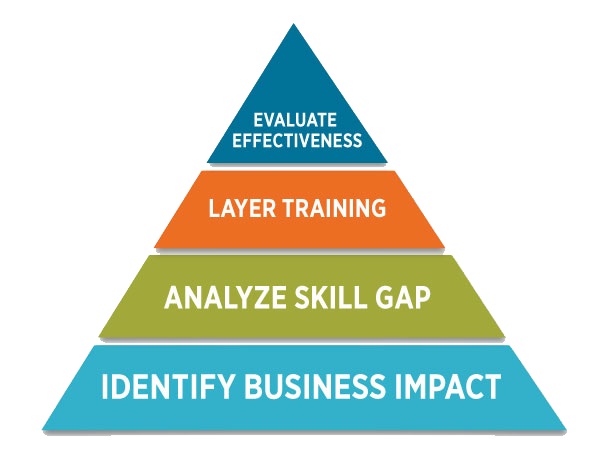
(Source)
The main starting point should be to define what “success” means to your company. This allows you to measure the results of your training or employee development program.
Action point: Answer the questions, “What do you want to achieve? What should be the business impact?”
4. Analyze Skill Gaps
The next step is to understand the gaps between each employee’s current skills and ideal skills. Find out what your employees need to know in order to fulfil the business goals you set during the previous step.
Dr Jennifer K. Stine advises to “start with your talent goals. What is it that your employees need to know or could do better, that will help your company grow, and, once acquired, will be seen in a positive light when it comes to performance reviews?”
One way to easily map skill gaps is the competency framework.
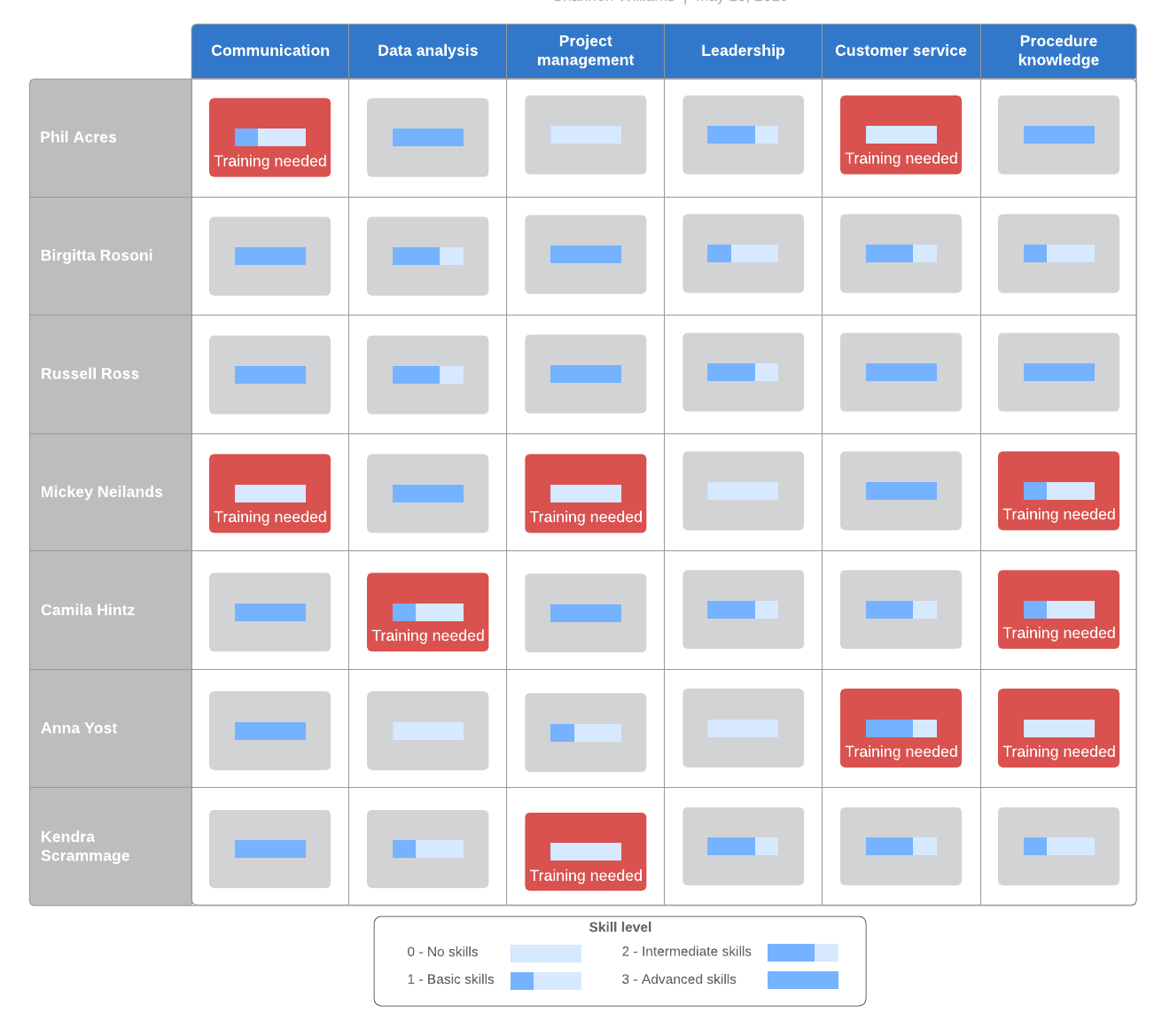 (Source. Competency Framework Example)
(Source. Competency Framework Example)
Action point: Once you understand the skill gaps, categorize your learning objectives into these three groups:
- Motivation. Identify the “why” behind your training and development strategy and the ways you’ll communicate it to employees.
- Skills mastery. Pinpoint the skills that will have the highest impact on business performance.
- Critical thinking. Prioritize critical knowledge to make your staff training and development program laser-focused and avoid distractions.
5. Layer Training Methods
Different people remember in widely different ways. So, there is no one-size-fits-all when it comes to learning development. That’s why one of the best practices in training and development is layered learning.
The premise is simple—enable employees to learn however they like and wherever they want.
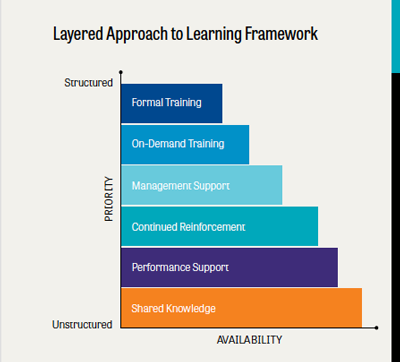
(Source)
By the way… sharing knowledge is one of the first steps to successful knowledge management which can, in turn, make it easier to train employees at scale.
6. Evaluate Effectiveness
If you set goals at the beginning of your training development, you will be able to track employee training progress and measure the impact in the end.
Action point: Use an evaluation framework such as the Kirkpatrick Evaluation Model.
7. Provide Continued Support
To create a lasting impact in your organization, you have to make sure that employees are actively using the knowledge and skills they have acquired.
Action point: Arrange refresher courses, continuously provide training materials, and schedule follow-up sessions to help employees retain and better apply the knowledge they’ve gained.
The Best Types of Training And Development Tools
Employee training and development software is a useful component of employee training as they help facilitate the learning process, increase engagement, and ensure that employees acquire the necessary skills and knowledge effectively.
Here are a few types of training and development tools that you should consider as you build your program.
1. Knowledge Base Software
If you scroll back up to the layered learning approach, you will notice that “Shared knowledge” is at the basis. Well, knowledge base software is a type of learning and development tool that allows employees to share knowledge. Instead of emailing a co-worker and waiting for an answer, the employee can simply search your knowledge base and find the information he or she needs immediately.
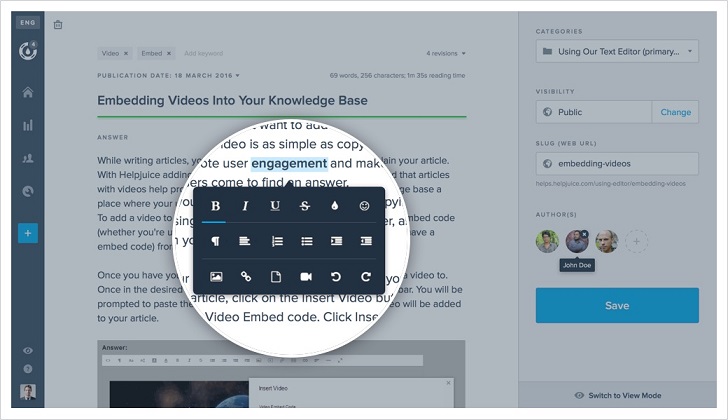
If you want to enable easy knowledge sharing, feel free to give Helpjuice a try.
2. Learning Management System (LMS)
An LMS is a specialized content management system that allows you to store and keep track of various types of learning materials such as employee training videos, text, and documents. Since they’re designed for online learning, LMS software usually come with specialized tools such as quizzes, badges and leaderboards. One of the most popular LMS tools today is SAP Litmos.
3. Learning Experience Portal (LXP)
LXPs are the cool hip cousins of LMSs. LXPs mirror common technologies people use in their day-to-day lives such as streaming video and social media. Often called “the future of workplace learning”, these tools have all the standard LMS features plus some additional features for a more immersive learning experience, e.g. a “Netflix-like” interface for streaming video.
4. Project Management Tools
Project management tools can help with quality control of any materials used in instruction of your employees as well as help with communication to team members and stakeholders.
"In today’s modern age, trainer and leadership collaboration is key to building an effective training program. If supporting departments are working by sending multiple emails, with attachments and version histories, then collaboration can get messy, communication can get overwhelming and attention to detail within the training resources can be missed.
Tools that you may want to consider include OneDrive which allows multiple trainers and key leaders to work in real-time on a training resource as well as Planner which provides transparency to an entire team and supporting partners by keeping the required tasks organized and assigned, increasing accountability and productivity." —Shaun Lowy, Director of Training & Development, PrimePay
5. Video Training Tools
If you’re simply looking to provide one-on-one training to remote employees or to run an online class, you probably don’t need a full-blown LMS or LXP. In this case, widespread employee video training can be your best friend. Your instructor can live stream a lecture or a workshop and learners can tune in from anywhere. Most platforms also come with live chat that allows participants to raise their hands when they need to.
Some of the tools you might want to consider are GoToMeeting, Zoom, and JoinMe.
6. Microlearning Platforms
Constant information overload is causing our attention spans to shrink every year. To overcome this problem, some L&D professionals are opting for microlearning platforms. These tools enable them to turn heavy training lessons into nuggets of knowledge and make information easier to digest. If you’re looking to implement microlearning, you can try a tool like TalentCards.
To further enhance your learning experience, the Headway app is another great option to explore. It offers concise, bite-sized book summaries that help you absorb key insights from popular non-fiction books, turning knowledge into easily digestible pieces, perfect for quick learning on the go.
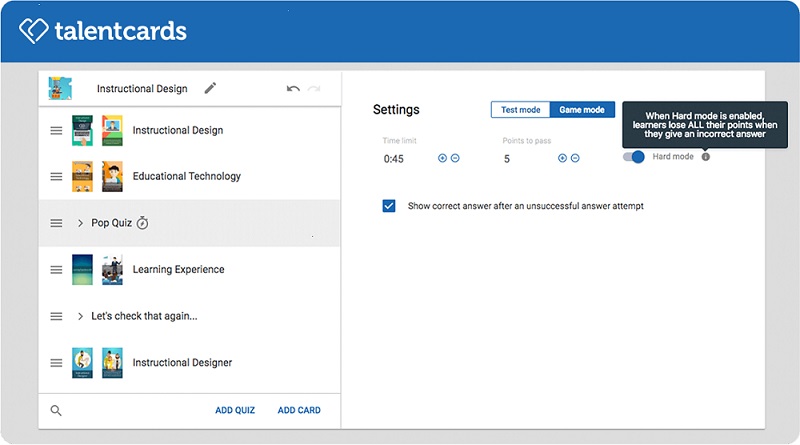
(Source)
7. In-app Training Tools
Imagine your sales team has just received the latest Salesforce update. The interface has changed, there are a ton of new features and, most likely, some of your salespeople are wasting time trying to find their way around the application. Or maybe, they’ll go on without even suspecting the existence of these new features.
This is where in-app training tools can help. They can provide just-in-time guidance and training for employees that are learning how to use a complex piece of software. If you’re looking for an in-app training tool, you may want to try Whatfix.
If You’re Wondering Where to Start…
This was a long post and a lot to take in. If you’re confused about where to start, there is one simple step you can take right now—enable knowledge sharing.
Give your employees the opportunity to share what they know with each other and there will be no more “I’m waiting for Bob to find some time and teach me how to use that program.”
All you need to kickstart your knowledge sharing initiative is a knowledge base platform like Helpjuice. Just create a free account, invite your team and they can start publishing nuggets of knowledge in a single searchable portal. All employees will be able to find the information they need at any time.
You can try Helpjuice's knowledge base software without any risk. The first 14 days are on us.

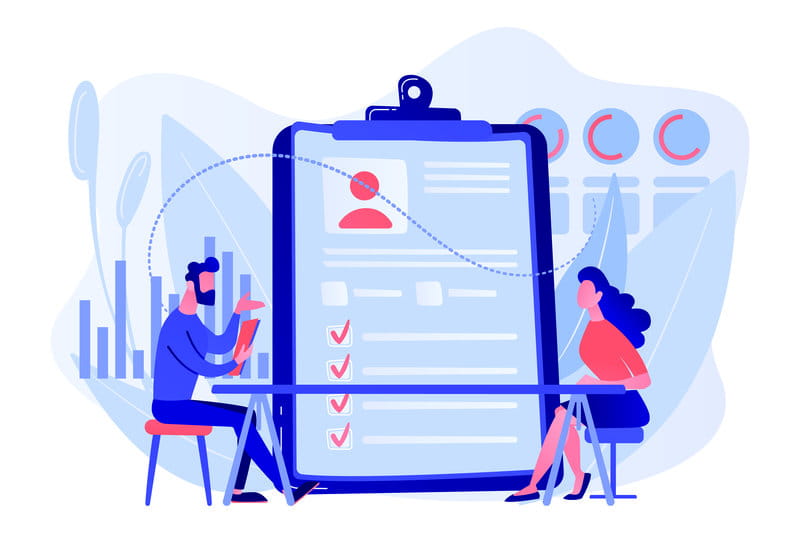
![The Best Employee Onboarding Software For New Hires [2025]](https://static.helpjuice.com/helpjuice_production/uploads/upload/image/4752/direct/1586534537882-1585969985471-Employee%20Onboarding%20Software.jpg)